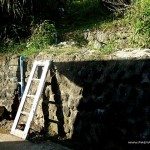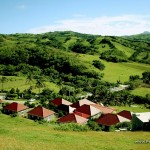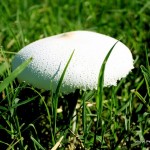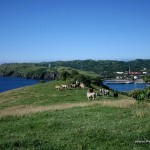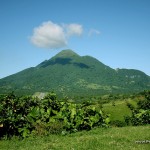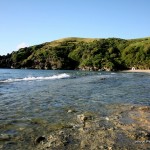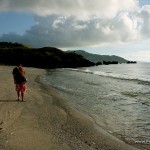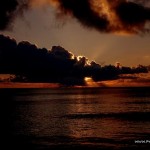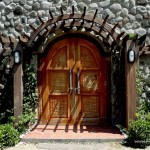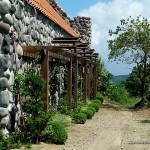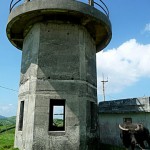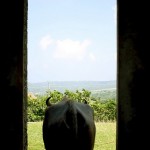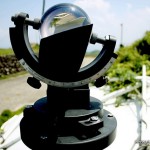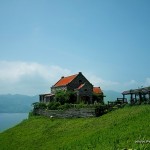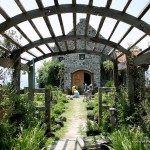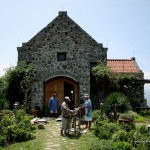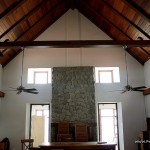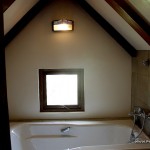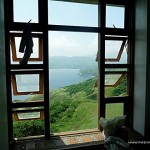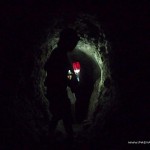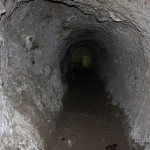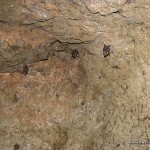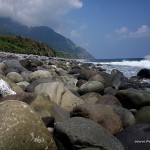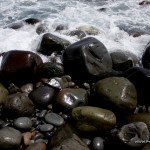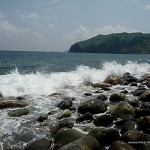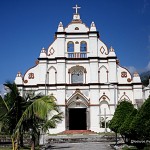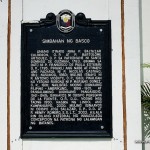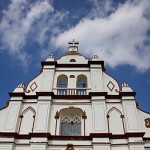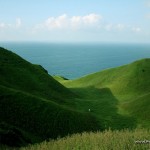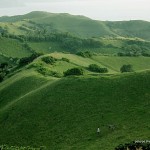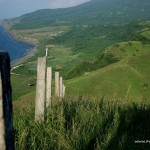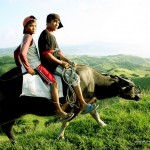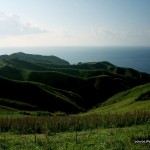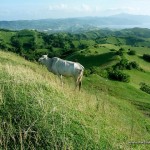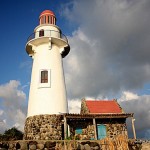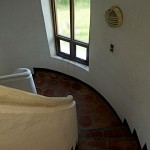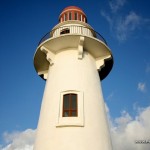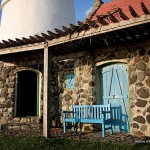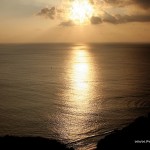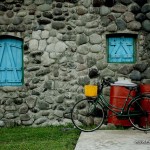Basco, also known as Santo Domingo de Basco, is considered to be the capital municipality of Batanes and is located at the northern part of Batan Island, the second largest island among the Batanes Islands . It has the domestic airport which serves flights coming from Manila. Its land consists mainly of rolling hills and mountains.
According to wikipedia, its town got its name after Capitán General José Basco, who led the Philippines to freedom from the control of New Spain (today known as Mexico) and based on the 2000 census, it has a population of 6,717 people in 1,469 households.
We arrived at Batanes Resort past 7 a.m., still sleepy from the early morning flight. As soon as we checked in, we went straight to our beds to get some rest. At around 4 p.m., we decided to go out for a walk. First, we went around Batanes Resort. While Wayne and I were busy taking pictures, we saw our friend Al climbing up the hill at the back of the resort. Al called us to follow him.
We started climbing using the ladder leaned against the wall. Going up, we saw a big white mushroom and a herd of cows on the other side of the barbed wire fence. From the top we also saw Mt. Iraya, Naidi Lighthouse, and the whole resort. After enjoying the views, we headed back down to Batanes Resort.
Marine Sanctuary
Just a few blocks away from the resort, we discovered an area full of trees and grass which looked like a forest of some sort. We don’t know what’s behind but our curiosity led us to go further. There’s a sign that read: “Marine Sanctuary”, so we checked it out and found an open sea. Then we realized that this is the beach we are seeing from our cottage at Batanes Resort. We spent the rest of the afternoon at Marine Sanctuary.
Before dark, we decided to get a tour guide as we are still clueless on how to go to the different scenic spots in Batanes. We have arranged a schedule with Kuya Nards of Batanes Resort to serve as our tour guide for the next 3 days.
The next day, we woke up early and got ready for our Basco tour. It was a beautiful sunny day and we had our breakfast at Batanes Resort. Kuya Nards came just right after we finished our breakfast. He waited for us while we prepare for the trip. We brought our cellphones and cameras with us, and made sure they were fully charged. Then we went to his van and proceeded with the tour. Our first stop was Tukon Chapel.
Tukon Chapel
Tukon Chapel was a project of Dina and Butch Abad for Tukon’s residents. Its architecture is similar to the Ivatan stone houses. Though the chapel was closed, we still had the chance to peek through its windows. Inside, there were murals of saints painted on the ceiling, which were said to have been hand-painted by Ivatan artists.
Radar Tukon
Not far from Tukon Chapel is the Radar Tukon. In Ivatan, radar means lighthouse and tukon means hill. Formerly used as a lighthouse, Radar Tukon now serves as the island’s weather station. Kuya Nards suggested to climb Radar Tukon to enjoy the 360 degree view of Basco. So we climbed Radar Tukon using the metal railings attached to the wall. Wayne went up first, then I followed. As I was about to reach the top, I noticed that the last railing was too far from the top. I actually didn’t know what to do. Good thing, Wayne helped me get to the top.
On top of Radar Tukon we saw the breathtaking views of the rolling hills and the rest of the island. We stayed for a while, took pictures of the Rolling Hills and enjoyed the strong winds of Basco.
As we were about to leave Radar Tukon, we noticed this small transparent sphere just across Radar Tukon. We don’t know what it is, but it looks interesting, so we took a picture of it. Then off we went to Fundacion Pacita.
Fundaction Pacita
Fundaction Pacita is another famous stonehouse-like structure in Basco. According to Kuya Nards, Fundaction Pacita was originally built as an art gallery of the late artist, Pacita Abad. But soon, it will be converted into a bed and breakfast facility. So that explains why when we entered the place, it was still under construction. We saw a sack of cement on the door entrance, a ladder up against the wall, and tables and chairs scattered all over the place. Surrounding Fundacion Pacita are plants that have been planted to form part of the landscaped garden but some haven’t fully grown as yet. Everything was raw and unfinished but I can already imagine how beautiful the place is going to be when it is done. That’s why I am very excited to see Fundacion Pacita when it opens.
Japanese Tunnel
The Japanese Tunnel served as a hideout of the Japanese soldiers during World War II. When we entered the tunnel, everything was pitch black. Though we had our own flashlights, Kuya Nards’ lamp lighted the way. As we moved deeper into the tunnel, we heard squeaking sounds coming from one of the chambers. Then, a group of bats came flying toward us. We brought out our cameras fast and took pictures of the flying bats. They just kept flying and passed over us. Luckily, we get to shoot a few of them just before they left the tunnel.
There’s also a part in the tunnel where we had to go down through a small opening. To get past that, we spread out our arms against the wall for support, then jumped down. The walls in this part of the tunnel are a little muddy so we had to be careful. Kuya Nards went down first, so he could guide us on our way down. We followed what he did. We were not able to hold our flashlights and cameras properly. We continued to walk some more and when we saw the light, we know we’ve finally reached the end of the tunnel.
Valugan Bay
Valugan Bay is famous for its bouldered shore. It is said that the large rocks that lay along the shore came from Mt. Iraya’s eruption a long time ago. We had to step on these rocks one after the other before we can reach the bay. Valugan Bay is perfect for picture taking and resting.
Basco Church
It was past lunch when we headed back to the town proper of Basco. We had our lunch at one of the canteens within the town, named SDCBI Canteen and Store Dept. After eating, we went to the oldest church in Batanes, the Santo Domingo de Basco Church which was also called the Basco Cathedral. The church was established in 1783 and was dedicated to the Immaculate Conception. Its present structure was built by the Dominicans in 1812 in espadaña style. It is also one of the first limestone buildings built during the Spanish regime.
Vayang Rolling Hills
Also known as Vayang Ranch, the Vayang Rolling Hills is another place that we wouldn’t want to miss in Basco. As we stand on top of the hill we saw a wide world of green grass and blue sky and felt the rushing of the wind against our faces. These are the moments we wish we could experience in the city.
Naidi Lighthouse
Inside, we took the spiral stairs leading to the top of the lighthouse. The view from the top showed us Mt. Iraya, the sea, and the rest of Basco. We did nothing but enjoyed the view and took pictures. We left after sunset.

